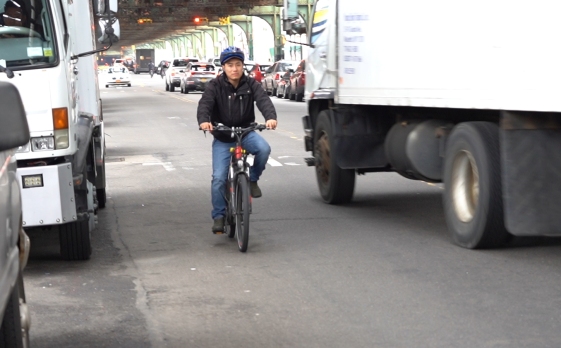OPINION: Ordering Takeout? Stop Complaining and Look in the Mirror
Entitled, app-using New Yorkers don't seem to understand their central role in creating unsafe streets.

The next time you ask a delivery worker to bring you pad Thai or a bagel from a restaurant 30 blocks away, consider: You are asking another human to risk dying or becoming severely injured because you didn’t want to leave your apartment. The next time you have to dodge a “wrong way” delivery bike rider, moreover, you also might think for a second: Could your impatience about “WHERE’S MY ORDER” be driving the interaction?

Many New Yorkers seem to think that restaurant food deliveries happen by magic. At any rate, they do not feel that the street conditions such deliveries create are their problem. I frequently hear complaints from friends and family that “those delivery riders are always going the wrong way!” or “they go through red lights!”
No one seems to pause and say, “I wonder why they would do that?” It’s as though “those people” are inherently lawbreakers whose behavior does not stem from any discernible rationale.
Indeed, every time I note that deliveristas depend on tips in order to earn even a subsistence wage, that many New Yorkers decline to put any money on top of the food delivery services’ already usurious fees, and that this imbalance places a ton of pressure on the riders to deliver as many orders as they can every shift, I get a “Huh, really?”
Ignorance may be bliss for the orderer, but it’s dangerous for the gig-economy worker.
So here we sit with our phones, ordering pad Thai and expecting it to show up — warm! — in 25 minutes from a “local” place that may be miles away. Yet, as anyone who has been inside a restaurant knows, getting the food off the counter and to the deliverista can be chaotic and takes time. The rider must unlock their bike (an expensive tool in a city in which bike theft is endemic), mount it, and head out into traffic. The shortest route to their destination likely will require mixing with cars and trucks, so the food that we want hot and fast comes at the potential cost of the deliverista’s life. In fact, at least 10 deliveristas died in traffic crashes last year.
Meanwhile, if bike lanes exist on a deliverista‘s route, they may not be safe: Many lanes require that cyclists mix with left-turning motorists at intersections; often lanes simply disappear just when they’re most needed. Plus, because many of us live on one-way blocks, it would take a few more minutes for that delivery if the deliverista goes the “right” way. So, instead, the “rational” decision for achieving an “on-time” order is to go the “wrong” way down the street — or even to ride on the sidewalk — because the street may not be safe for a cyclist going the “wrong” way.
If a deliverista doesn’t choose to do all of this, he or she may be kicked off a delivery company’s app for being “inefficient.” It’s odd that I almost never hear anyone complaining about the delivery companies, only about the people who they force to work at a furious pace, a built-in exploitation that the apps don’t advertise to the end user (indeed, watch any Uber Eats commercial; the food always shows up promptly, delivered by a disembodied hand). The apps also make deliveristas compete for the “best” orders (say, a $200 food order to an NYU dorm) with most having to start at the bottom (a $10 order with two drinks they must not spill). The hustle is endless, and the struggle is real. The deliveristas are organizing in order to secure redress for some of these issues through the City Council.
When I was a kid, I had no idea where the chicken breasts in plastic wrap came from. Sure, I knew we bought them at a supermarket, but beyond that I did not know about farms and chickens. I just assumed there was a chicken-breast machine somewhere.
I’m an adult now, and I know about factory farming and the none-too-pleasant way that a live animal arrives as a set of plastic-wrapped parts at the supermarket. I still eat meat, but I do so consciously. Maybe it’s time that New Yorkers started ordering more consciously while complaining less about “wrong-way riders.”
Robert Green (@robogreen) is the strategic communications director of Open Plans.





